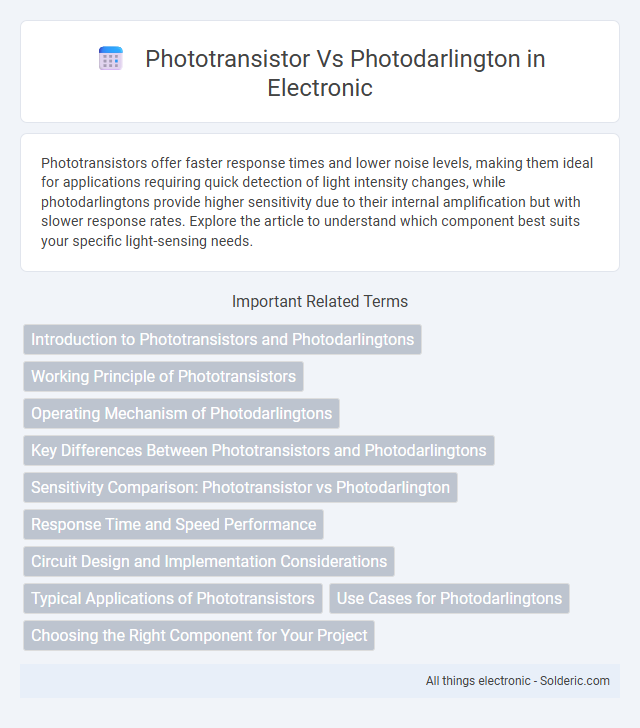Phototransistors offer faster response times and lower noise levels, making them ideal for applications requiring quick detection of light intensity changes, while photodarlingtons provide higher sensitivity due to their internal amplification but with slower response rates. Explore the article to understand which component best suits your specific light-sensing needs.
Comparison Table
| Feature | Phototransistor | Photodarlington |
|---|---|---|
| Structure | Single transistor | Two transistors in Darlington pair |
| Sensitivity | Moderate | High (higher gain) |
| Response Time | Faster | Slower due to additional transistor |
| Gain | Low to moderate | High (up to 1000x) |
| Output Current | Lower | Higher |
| Application | Simple light detection | Low-light detection, high gain requirements |
| Cost | Lower | Higher |
Introduction to Phototransistors and Photodarlingtons
Phototransistors and photodarlingtons are semiconductor devices that convert light into electrical signals, widely used in optical sensing applications. Phototransistors amplify the photocurrent generated by light absorption directly, offering faster response times and simpler circuits. Photodarlingtons consist of two transistors connected to provide higher current gain, making them ideal for applications requiring greater sensitivity but with slightly slower response.
Working Principle of Phototransistors
Phototransistors operate by converting light into electrical current using a semiconductor junction where incident photons generate electron-hole pairs, amplifying the current through transistor action. The base region in a phototransistor acts as a photodiode that controls the collector current in response to light intensity, enabling faster switching and higher sensitivity compared to photodiodes. Photodarlingtons consist of two transistors connected in a Darlington configuration, providing higher current gain but slower response time due to increased charge storage, differentiating their working principle from single phototransistors.
Operating Mechanism of Photodarlingtons
Photodarlingtons operate by combining two transistors in a Darlington configuration, which amplifies the photocurrent generated by the photodiode section, resulting in higher current gain compared to single phototransistors. This dual-transistor setup allows photodarlingtons to detect low levels of light with enhanced sensitivity while maintaining rapid response times. Understanding this operating mechanism helps you select the right device for applications requiring precise light detection and amplification.
Key Differences Between Phototransistors and Photodarlingtons
Phototransistors have a simpler structure with a single transistor that responds to light, offering faster switching speeds and lower saturation voltage compared to photodarlingtons. Photodarlingtons consist of two transistors connected for higher current gain and sensitivity but exhibit slower response times and higher saturation voltage. The choice between them depends on the application's need for speed versus sensitivity in light detection.
Sensitivity Comparison: Phototransistor vs Photodarlington
Photodarlington sensors exhibit significantly higher sensitivity compared to standard phototransistors due to their internal transistor pair configuration, which amplifies the photocurrent more effectively. This increased sensitivity allows photodarlingtons to detect lower light levels and produce stronger output signals in low-illumination conditions. However, phototransistors typically offer faster response times and lower output saturation voltage, making them suitable for applications requiring rapid switching.
Response Time and Speed Performance
Phototransistors exhibit significantly faster response times compared to photodarlington transistors due to their simpler two-layer structure, allowing quicker electron flow and improved switching speed. Photodarlington devices, composed of two transistors in a cascade, introduce higher gain but suffer from increased response times and slower speed performance, making them less suitable for high-speed applications. In optical sensing circuits where rapid signal detection is critical, phototransistors are preferred for their low latency and better frequency response characteristics.
Circuit Design and Implementation Considerations
Phototransistors offer faster response times and simpler circuit designs due to their single-transistor structure, making them ideal for high-speed applications. Photodarlington devices combine two transistors for higher sensitivity and gain, requiring careful biasing and additional components in the circuit to prevent slower switching and saturation issues. When designing your circuit, consider the trade-off between sensitivity and speed to ensure optimal performance for your specific application.
Typical Applications of Phototransistors
Phototransistors find typical applications in light sensing, optocouplers, and alarm systems due to their fast response and moderate sensitivity. They are widely used in remote controls, optical switches, and ambient light detection, enabling precise and reliable operation. Your projects benefit from phototransistors' ability to convert light into electrical signals efficiently in various consumer electronics and industrial automation systems.
Use Cases for Photodarlingtons
Photodarlington transistors are ideal for low-light detection applications due to their high current gain, making them effective in optical sensors, light meters, and remote control receivers. They excel in scenarios requiring amplified output signals from weak light sources, such as fiber optic communication systems and smoke detectors. Photodarlingtons are preferred in circuits demanding higher sensitivity and signal strength compared to standard phototransistors.
Choosing the Right Component for Your Project
Phototransistors offer faster response times and simpler circuitry, making them ideal for applications requiring quick light detection and minimal amplification. Photodarlingtons provide higher gain and sensitivity but introduce longer switching delays and increased power consumption, suitable for low-light environments where signal strength is critical. Selecting between the two depends on balancing speed, sensitivity, and power constraints specific to your project's requirements.
phototransistor vs photodarlington Infographic

 solderic.com
solderic.com